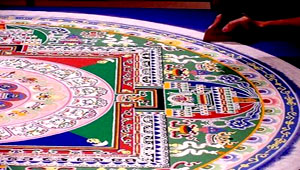
|
Indian art is an expression of Indian life and thought attuned to its vast natural background and its socio-religious traditions. Its style, technique or general tenor has nothing to do with any particular religious outlook. The term Hindu, Jaina or Buddhist art is but a popular nomenclature to distinguish one group of monuments, including painting, cave-temples and architecture, etc., from another. Hence, by Buddhist Art we mean those monuments and paintings, which were built for the main purpose of popularizing Buddhism. In India there are innumerable monuments representing different phases of Buddhism, which help us to visualize the trend of Buddhist art through the ages.
In the earliest art forms of Buddhism in India, the Buddha was not represented in human form. He was indicated by a symbol associated with some of the important events of his life. There are six symbols, namely, Elephant for birth of Buddha, Lion and Footprint as representation of Buddha, an Empty Throne as representation of royalty, Horse for renouncement of worldly pleasures, Tree for enlightenment and a Stupa. Buddhist Art of Bharhut, Sanchi, Bodh gaya and Amaravati and other places shows no anthropomorphic representation of the master.
A new school of art flourished in the Gandhara region, i.e. Peshawar and its neighboring districts. This period (1st-2nd century A.D.) is remarkable in that it produced the first figurative representation of the Buddha. The artists of this region have produced a large number of Buddha and bodhisattva images along with other Buddhist deities. The main centers of Gandhara art were the cities of Peshawar and Taxila, and also Afghanistan where a large number of stupas, monasteries and sculptures have been unearthed by the archaeologists.
Mathura also was a great center of art and culture during this period. It is believed that the first Buddha images were carved at Mathura simultaneously if not earlier, with the Gandhara school. Mathura has produced Buddha images of various dimensions. The Kushana Buddha or bodhisattva images of Mathura served as the prototypes of the more beautiful specimens of the Gupta period. The workshop of Mathura exported several Buddhist images to various other places, such as Sarnath and even as far as Rajgir in Bihar.
The Gupta period (4th - 6th century A.D.) marks the bright period of art in India. The main centers of Buddhist art during this period were Mathura, Sarnath and Nalanda in the north. The Buddhist images of Mathura and Sarnath are some of the best specimens of Indian art, never equaled by any art creations of later period. The Gupta artists showed an equal ingenuity in the carving of metal images also.
Buddhist Art evolved gradually over the centuries to incorporate a pantheon of deities, including Maitreya or the future Buddha, bodhisattvas and Dhyani Buddhas. Buddhism continued in its esoteric form in the countries like Nepal and Tibet when it declined in India during the 12th century A.D
|
|
| |

